This is the third part of the Kitchen Essentials series (part I, part II). Whether you’re stocking a new kitchen or just updating a few things, this is a great place to start.
When you’re moving out of home for the first time, performing a major kitchen overhaul or rebuilding following less-than-ideal circumstances; stocking a kitchen can be a daunting task. Fortunately, with a bit of careful purchasing, it can also be a very rewarding one.
If you’re starting from scratch, the following will get you well underway. I’ve separated the lists so that they can be used even if you’re only looking at one or two aspects. On to the good part :
Whitegoods
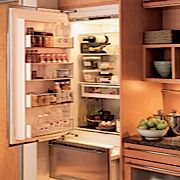 The large items are perhaps obvious, but when you’re estimating the total cost, make sure to include the following :
The large items are perhaps obvious, but when you’re estimating the total cost, make sure to include the following :
- Refrigerator
- Freezer (either standalone or as part of the ‘fridge‘)
- Dishwasher
Things to consider :
- Buy the most energy-efficient and water-efficient appliances you can afford. Although they usually cost a little more to begin with; they’ll save you a massive amount of money over the years.
- All of the above appliances work most efficiently when full (this doesn’t mean packed to the point of overflowing, just free from large, open spaces. Getting the right size for your needs will also save you money in the long run.
- When possible, allow a little room around the appliance (especially at the back and over the top) for airflow. Once again, this will increase the appliances’ efficiency and keep more cash in your pocket.
Major appliances and gadgets
In the same vein as the whitegoods above, these are fairly obvious (but important to budget for, all the same). The big ones are :
- Oven
- Stovetop (aka range, hob, hotplates and a number of other things)
- Electric BBQ
- Microwave oven
- Food processor
- Blender
- Bread maker
Things to consider :
- Both the food processor and bread machine were discussed briefly in the article ‘7 Essential Kitchen Gadgets‘ – including costs.
- Items such as the ‘Electric BBQ’ will depend upon your style of cooking. Personally, I use mine on a regular basis during the warmer part of the year.
- The oven, stovetop and microwave all benefit from the same energy-efficiency arguments noted above. By buying the most efficient appliances you can afford, you’ll save a considerable amount over the long term.
Cutlery and Crockery
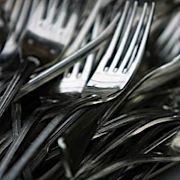 How many knives do you need? How many forks? How many spoons? What about sporks, chopsticks, corn holders and the myriad of occasional use items?
How many knives do you need? How many forks? How many spoons? What about sporks, chopsticks, corn holders and the myriad of occasional use items?
The simplest way to begin is to purchase a complete set – these are generally pretty close to the number you need. As long as there are knives and forks for a minimum of 4 people, you’ll be fine.
The same idea applies to purchasing crockery. Sets of 4 are the norm, and extra pieces are usually available individually.
Things to consider :
- When buying knives and forks, look for sets catering for a minimum of 4 people. If there are an odd number of people in your household, buy cutlery for this number plus one.
- If you’re only looking for crockery for 1 or 2 people, charity stores are often a good bet. After all, why buy a set of four when you don’t need it?
Tools
There is an incredible array of gadgets available to open, slice, core, mince and reshape almost any type of food you choose to work with. In many cases these can be purchased on an ‘as needed‘ basis (and after living without them for a while, you may find that the ‘need‘ disappears.
There are, however, a few items that will make life easier right from the start. These are :
- can opener
- bottle opener
- ladle
- strainer
- kitchen knife
Everything else can wait for now. Keep your money in your pocket.
Things to consider :
- I seem to have collected hundreds of these items over the years, and I can honestly say that most of them rarely see the light of day. The above list, however, is used on a daily basis.
The other items often found with these are generally found near the checkouts of kitchenware stores. Be strong.
- One good quality knife is often all you’ll need (see the Knife Buyer’s Guide)
Glassware, cups and mugs
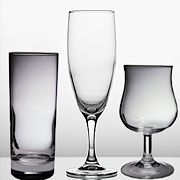 I don’t know about you, but most of my glasses, cups and mugs were either free or extremely cheap. This doesn’t mean that they are poor quality or acquired through nefarious means; simply that this doesn’t need to be an expensive part of the kitchen.
I don’t know about you, but most of my glasses, cups and mugs were either free or extremely cheap. This doesn’t mean that they are poor quality or acquired through nefarious means; simply that this doesn’t need to be an expensive part of the kitchen.
When it comes to acquiring glassware and cups without breaking the bank, try these :
- Ask for specific sets as wedding, birthday and christmas presents
- Keep an eye out for the handing out of ‘freebies’ in offices and large public areas
- Buy bulk lots (including a few pieces you want) at auctions, market stalls and garage sales – resell the remaining items on eBay
- Watch out for giveaways at pubs and clubs; these often include glassware
- Buy alcoholic ‘gift sets’ of a bottle and glass/es the day after holidays; they’ll often be back to the price of the bottle itself
If – after trying these – you find that you still want a piece or two, there are several inexpensive places to check out. These include :
- catering shops (specifically those that supply glassware to pubs and clubs) : as you can imagine, the glassware here is usually very reasonably priced
- local auctions, markets and garage sales : re-wrapping and packing glasses can lose its novelty value in a hurry, so it’s often possible to purchase large sets at budget prices
- charity stores : these seem to specialise in incomplete sets (one or two pieces has already been broken), with matching prices – great places to shop
Things to consider :
- As with the cutlery and crockery, glassware, cups and mugs are often sold in sets designed for either 4 or 6 people. Keep this in mind when asking for sets as presents – they’re not always inexpensive.
Pots ‘n’ pans
For me, this is where the fun really begins. As with most things, I prefer a small gathering of quality items to a large set of things I’ll never use. The following will keep you in good stead for most dishes :
- frying pan
- wok
- a saucepan or two (with lids)
- stockpot (with lid)
These can be used for most things – anything else can be easily purchased on an ‘as required‘ basis.
Things to consider :
- Large sets may seem like a simple way to go, but they’re not always cheaper. Shop around, and take a look at the cost of individual items.
- The heating method and surface may determine the type of materials you use. For example, induction cooktops require the pots and pans to be magnetic. Iron is common.
Manchester
I’m not talking about interior design here. In fact, all you really need are tea-towels (think of the number you’ll need, and triple it) and oven mits. Everything else can wait for now (unless there’s a special occasion coming up, of course).
Things to consider :
- I’ve got a restaurant mentality when it comes to tea-towels. I generally get a large quantity of identical, simple towels and use them once each (before washing, that is). Stores such as Ikea are great for items such as this.
- Oven mitts are not always considered essential items, but I’ve always used them regularly. On that basis alone, it’s worth buying them right at the start.
Personal favourites : the single mits that are connected with a wide strap of the same material (the picture will show you what I mean). The first time you take a large dish out of the oven, you’ll understand why.
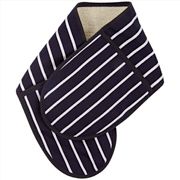
Herbs
I grow my herbs outdoors (as part of a compact vegetable garden), but most of them are equally happy indoors. Growing them is pretty straightforward (plants + soil + water + light), and can really make a difference to your kitchen. As well as the constant availability of fresh herbs, you’ve got the aromatic benefits of plants such as mint. Beautiful.
Things to consider :
- The easier it is to get to the herbs, the more likely they are to end up being used. Keep them nearby when possible.
- Most herbs are pretty easy to grow – however they generally don’t like being regularly smoked and covered with hot oil. Put them next to a window rather than right beside the stove.
Spices
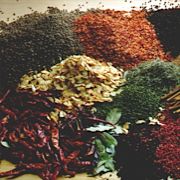
There’s more to the spice rack than simply salt and pepper – at least there can be. Your perfect spice collection just depends on the type of food you prefer, but here are a few that should keep you going for quite some time :
- Salt and pepper
- Nutmeg, Cinnamon and Cloves
- Turmeric, Chili Powder, Paprika and Cumin
The following are often found in the same section of your local supermarket, although they’re not actually spices :
- Coriander, Parsley, Rosemary, Oregano, Basil, Mint, Tarragon and Thyme
- Dill, Fennel, Marjoram and Saffron
- Mustard, Poppy and Sesame seeds
- Ginger
- Lemon
- Garlic
- Vanilla beans
As I mentioned above, feel free to alter (or reduce) this list to fit in with your own tastes.
Things to consider :
- These will actually cost quite a bit when first purchased, but they’ll last you for months.
- You may decide to grow several of the above items yourself. This is definitely the way to go.
Condiments
Sauces, preserves and jellies can be fun to make (as you may have guessed, I spend a fair bit of time in the kitchen). If, however, you prefer to spend your time doing other things; there are plenty to choose from.
Still, if you are going to buy them, why not cut down the number and get the good stuff. Buy 3 of the ones you’ve always wanted to try, rather than 6 of the things you always get.
Things to consider :
- Condiments are designed to enhance the food, not alter it completely. Taste the food without the sauce, and you’ll really appreciate the difference.
- Many of these items can be purchased in bulk, at greatly reduced prices (larger containers, designed for use in restaurants, pubs and cafes).
Foundation foods
If you’ve just finished moving or building your house, the idea of your perfect meal is probably something in a big red bucket. However, once normal life resumes, include the following on one of your first shopping lists :
- large joints of meat you can freeze : when you get these home, just cut them up into meal-sized portions, bag them and throw them into the freezer
- bags of frozen berries : berries are great for hundreds of things, such as cereal, pancakes, smoothies, muffins and desserts (healthy, of course). buy them in bulk, keep them in the freezer and enjoy a little luxury without spending a fortune (they’re much cheaper this way)
- spices and condiments : grab a few of the ones noted above – in bulk, where possible
- bakers’ flour and yeast : that fresh bread smell just can’t be beaten
- tea and coffee : although I usually have at least 7 varieties of tea in the cupboard (yes, I drink a lot of the stuff); one is probably enough to begin with
- frozen vegetables : although it’s great to spend hours preparing elaborate meals, sometimes this just isn’t possible (or desirable). To make it easy to have a reasonably healthy meal ready in a short time, grab a couple of bags of pre-cut frozen vegetables. A short spin in the microwave is all they’ll need.
For everything else, you can just buy it on an ‘as needed‘ (or ‘as desired‘) basis. Fresh fish, root vegetables and so on.
Final thoughts on Stocking a New Kitchen
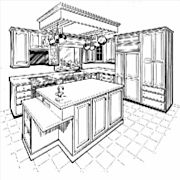 The kitchen is still my favourite room in the house, and is likely to remain in pole position. Stocking a new one is a great opportunity to set things up just the way you like them.
The kitchen is still my favourite room in the house, and is likely to remain in pole position. Stocking a new one is a great opportunity to set things up just the way you like them.
Enjoy.
This is the third part of the Kitchen Essentials series. If you missed the first two parts, here they are :
Comments are closed.